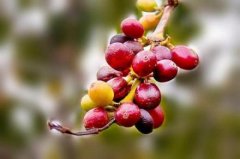Coffee shop fancy coffee menu recommends latte
Latte is the Italian transliteration of "Latte", which means "milk". In the English world, latte generally refers to coffee brewed with hot milk. Latte is a classic blend of Italian espresso and milk because it contains a lot of milk and is very suitable as a breakfast drink.
Italian latte (Cafe Latte):
The practice is extremely simple: pour nearly boiling milk into the freshly made espresso (steam from an espresso machine to steam hot milk). The general ratio is 1/3 espresso Espresso and 2/3 hot milk, which has a higher proportion of milk than cappuccino Cappuccino. In fact, there is no rule on how much milk to add and can be freely mixed according to individual taste. Lattes generally use mugs because they have more milk.
American latte:
If you add some cold milk foam to the hot milk, it becomes an American latte. Starbucks American lattes are made in this way, with espresso at the bottom, milk heated to 65 to 75 ℃ in the middle, and cold milk foam of no more than half a centimeter.
Allusions to Cafe Latte:
The famous phrase "I'm not in the cafe, I'm on my way to the cafe" was said by a musician in Vienna. The air of Vienna is always filled with the smell of music and Latte coffee. The first person to add milk to the coffee was Kochsky of Vienna, who also opened the first coffee shop in Vienna.
In 1683, the Turkish army attacked Vienna for the second time. The then Emperor Augustus I of Vienna had an offensive and defensive alliance with King Augustus II of Poland, and as soon as the Poles heard the news, reinforcements would arrive quickly. But the question is, who will break through the siege of the Turks to deliver letters to the Poles?
Kochsky, a Viennese who had traveled in Turkey, volunteered to deceive the besieged Turkish army in fluent Turkish, crossed the Danube and moved to Poland. Although the Ottoman army was brave and skillful, it retreated hastily under the attack of the Polish and Viennese armies, leaving behind a large number of military supplies outside the city. Among them were 500 bags of coffee beans-coffee beans that the Muslim world had controlled for centuries and refused to flow out so easily reached the Viennese. But the Viennese didn't know what it was, and only Kochsky knew it was a magical drink.
So he asked for the 500 bags of coffee beans as a reward for breaking through the siege and used the trophies to open Vienna's first coffee shop, Blue bottle. At first, the business of the cafe was not good. The reason is that people in the Christian world do not like to drink coffee grounds as Muslims do; in addition, they are not used to this dark and bitter drink. So the clever Kochsky changed the recipe, filtering out the coffee grounds and adding a lot of milk-this is the original version of the latte that is common in cafes today.
Important Notice :
前街咖啡 FrontStreet Coffee has moved to new addredd:
FrontStreet Coffee Address: 315,Donghua East Road,GuangZhou
Tel:020 38364473
- Prev

Coffee shop fancy coffee recommends Olei coffee
French milk coffee, or coffee Olei, is called Caf au lait in French, which means coffee with a large amount of milk (le lait). It tastes smooth and smooth, with rich bovine frankincense in the mellow coffee. O'Rey can be seen as a French latte. Ole Coffee is also very simple, requiring a cup of espresso and a cup of hot milk.
- Next

Coffee common sense black coffee without any embellishment
Black coffee is unembellished coffee, black coffee brings the original feeling of tasting coffee. Black coffee combines the characteristics of sweet, sour and bitter coffee. It is primitive and rough, profound and intriguing. Black coffee emphasizes the aroma of coffee itself. Aroma is not only the life of coffee quality, but also the best expression of coffee production process and roasting technology. Climate, variety, refinement of the place of production
Related
- Beginners will see the "Coffee pull flower" guide!
- What is the difference between ice blog purified milk and ordinary milk coffee?
- Why is the Philippines the largest producer of crops in Liberia?
- For coffee extraction, should the fine powder be retained?
- How does extracted espresso fill pressed powder? How much strength does it take to press the powder?
- How to make jasmine cold extract coffee? Is the jasmine + latte good?
- Will this little toy really make the coffee taste better? How does Lily Drip affect coffee extraction?
- Will the action of slapping the filter cup also affect coffee extraction?
- What's the difference between powder-to-water ratio and powder-to-liquid ratio?
- What is the Ethiopian local species? What does it have to do with Heirloom native species?

